Side Hit In The Surf Zone
By Wayne Horodowich
The surf zone can be a fun place , but for many it is a place that raises anxiety levels and conjures up thoughts of wipeouts and carnage. While I will admit I have my fair share of terrifying stories regarding my time in the surf zone, as an instructor I still advocate the fun aspect of it, as long as your are properly trained and prepared.
There are many ways to look at the surf zone. One as a necessary evil in order to get to your days paddle. Another is to just sit and appreciate it as a liquid symphony/ballet composed by King Neptune and choreographed by Mother Nature. Another is to think of the surf zone as a playground.
Understanding the forces in the surf zone is a critical element for padding in it. See USK article, "Launching A Kayak Through Surf", for a brief explanation of those forces. Whether your goal is to play in the surf zone or just get through it, I firmly believe a paddler must learn how to take a "side hit" by a whitewater wave and a breaking wave if they plan to enter a surf zone. Sooner or later a paddler will find themselves in the surf zone with their kayak parallel to an oncoming wave. Of all of the forces you will encounter, the side hit is the one that causes the greatest number of capsizes.
This article is going to focus on the water dynamics, boat position, body position and the blade position for staying upright when taking a side hit from a wave. As always, dressing for immersion, wearing your PFD and helmet are givens when you enter the surf zone. Proper clothing has an additional benefit in the surf zone aside from addressing water temperature concerns. Depending on your particular surf zone, being properly dressed can keep the body parts from being cut and abraded. I also need to emphasize that you should learn your surf zone skills in mild surf before you move into practicing your skills in larger waves. The consequences in small surf are less than the ones in large or even moderate surf. I also recommend learning these skills from an experienced and qualified instructor. As a side note, all of these pictures (except the first one) are of students in a beginning surf class in low surf conditions.
Whether you take a class or try to do this on your own, remember your kayak can be a weapon. Please think ahead to the damage you can cause to others when you take your kayak into a surf zone. Please be sure to read USK article, "Surf Zone Responsibilities".
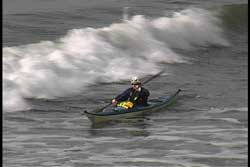 Here is what many see as their worst case scenario. Your kayak is parallel to an oncoming whitewater wave. This wave has just broken and the wave energy going through the water will push this whitewater forward towards shore. This is unlike the swell zone where the wave energy just lifts your kayak as the swell passes under. This whitewater wave is a moving force that is coming at you and your kayak.
Here is what many see as their worst case scenario. Your kayak is parallel to an oncoming whitewater wave. This wave has just broken and the wave energy going through the water will push this whitewater forward towards shore. This is unlike the swell zone where the wave energy just lifts your kayak as the swell passes under. This whitewater wave is a moving force that is coming at you and your kayak.
We know that we need to be perpendicular to the wave and have momentum if we want to punch through it. If we are parallel to the wave there is zero chance of punching through it. When this whitewater wave hits the broached kayak (parallel to the wave), the kayak will feel more force upon it as compared to being in the perpendicular position (punch through position.) Once you know how the broached kayak is going to react to the wave, then you can prepare yourself and your kayak to take this hit and remain upright.
When a kayak is flat on the water the hull provides some resistance to the water. The ridge line created by the keel, bow and stern adds even more resistance if the kayak were moved sideways. This resistance will cause the kayak to roll over when pushed hard enough from the side. If you wish to keep your kayak from rolling over when hit by a wave from the side, you need to put that kayak on edge with your deck tilted toward the wave. This is the key element to keep from being knocked over. If your kayak is NOT edged properly, then you will get knocked over when the wave hits the side of your kayak.
This is a good time to review two different terms. Edging vs leaning. You edge your kayak and lean your body. Edging your kayak simply means to get your kayak on edge. Another way of stating it is, you tilt your kayak. Leaning is referred to moving your body from its center position. You can lean forward, backward or to either side. The process of leaning your body changes how your kayak sits in the water. If you lean forward the bow lowers. If you lean back, you lower the stern and raise the bow. If you lean to either side, your kayak will begin to edge. How much your kayak moves depends upon your kayak design, your weight and how much you lean. One additional term to mention is your balance point. If you lean forward or back your kayak will not capsize. However, if you lean to the side you can flip over once your body weight moves past the capsize (balance) point. In boat design it is generally agreed upon that the narrower the kayak (given same hull design) the sooner you will capsize when you lean to the side. Therefore, leaning your body to edge your kayak, has its limits before you get to your capsize point.
There is another way to edge your kayak without leaning your body, which lessens your capsize potential. When you lift one knee and pull it up to your thigh brace while relaxing the opposite leg, your kayak will begin to edge. The beauty of this method is it keeps your body in its center position over the kayak. You are not leaning over the side, thus keeping away from your capsize point.
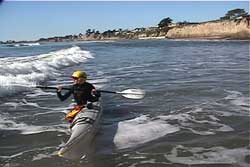 In this second illustration, the paddler is waiting to take the side hit with their kayak on edge. You will also notice they are NOT leaning over the side to edge their boat. They are still centered over their kayak with their kayak on edge by lifting the knee opposite the wave. In addition, this paddler is waiting in a high brace position which will be discussed after reviewing boat and body movements.
In this second illustration, the paddler is waiting to take the side hit with their kayak on edge. You will also notice they are NOT leaning over the side to edge their boat. They are still centered over their kayak with their kayak on edge by lifting the knee opposite the wave. In addition, this paddler is waiting in a high brace position which will be discussed after reviewing boat and body movements.
Once you are properly edged, you need to understand what the forces are going to do to you and your kayak. When the side hit occurs, the force will try to roll the kayak and it will also knock the kayak out from under your balance point. By maintaining the correct edging position, you accomplish two things. First you are keeping yourself locked into your cockpit. If you were to go limp below the deck, you can end up having your kayak pulled right off of your body. Second, you keep the kayak from rolling over toward shore by holding your edge. Your kayak will side slip over the water instead of rolling over. How much you need to edge your kayak depends upon boat design and the magnitude of the force.
Once your kayak is knocked out from underneath you, you will find yourself capsized toward the wave. This is where the brace comes in. You can choose to use a high brace or a low brace. The choice is yours and there are advantages and disadvantages to either. See USK article, "High Brace And Low Brace Blade Mechanics". In these examples, all of the paddlers have chosen to use a high brace. Here is a good time to review shoulder safety. It is worth your while to read USK article, "Shoulder Safety".
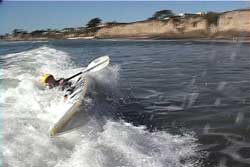 You can see that the paddler is over on their side, because the wave knocked the kayak out from under their center of gravity. Their body has ended up in the soup (Whitewater). The reason they do not go completely over is because they are using their paddle as a brace. In the previous picture you see the paddler ready in the high brace position while they edged their kayak. Now you see why. The bracing blade, which is in the water, is being lifted by the very force that is pushing the whitewater toward shore. In fact, the larger the wave the more lift that is provided.
You can see that the paddler is over on their side, because the wave knocked the kayak out from under their center of gravity. Their body has ended up in the soup (Whitewater). The reason they do not go completely over is because they are using their paddle as a brace. In the previous picture you see the paddler ready in the high brace position while they edged their kayak. Now you see why. The bracing blade, which is in the water, is being lifted by the very force that is pushing the whitewater toward shore. In fact, the larger the wave the more lift that is provided.
If this paddler maintains this position while they move toward shore, they would remain partially up until the forces on the kayak and the paddle dissipates. Then they would capsize toward the wave. In other words, as the energy from the waves lessens (as the waves moves toward shore) the lifting force on the paddle also lessens. Therefore, if the paddler keeps their upper body weight on the paddle, as seen in the illustration, the paddler will eventually sink when there isn't enough lift on the paddle (bracing blade). I will admit that I have been hit by some very big waves that I rode sideways to shore, resting my body weight on my blade the entire way and never capsized, because the lift from the wave was sufficient. However, that is not the norm. Most of the time, you will run out of lift from the whitewater wave, as it decreases in size, as the wave gets closer to shore. If you want to keep from capsizing toward the wave, then you need to get your balance point (your body weight) back over your kayak.
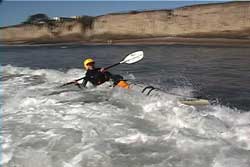 As you can see, the paddler has moved their body position from over the paddle, to back over their kayak. While doing so, they have also kept their kayak on edge. If they sat completely upright, with their kayak flat to the water, they would be rolled over toward shore. Your goal should be, to take the hit and regain your balance point over your kayak as soon as you can. Your brace allows you to move your body back over your kayak. Once balanced over your kayak, you still need to maintain your brace on the wave. By keeping your weight over your edged kayak, you will need very little lift from the wave, on your brace, to keep you upright. As you advance, you will see that being balanced over your kayak, while side surfing toward shore, will provide you with numerous options, as compared to resting your body weight on your brace until you sink.
As you can see, the paddler has moved their body position from over the paddle, to back over their kayak. While doing so, they have also kept their kayak on edge. If they sat completely upright, with their kayak flat to the water, they would be rolled over toward shore. Your goal should be, to take the hit and regain your balance point over your kayak as soon as you can. Your brace allows you to move your body back over your kayak. Once balanced over your kayak, you still need to maintain your brace on the wave. By keeping your weight over your edged kayak, you will need very little lift from the wave, on your brace, to keep you upright. As you advance, you will see that being balanced over your kayak, while side surfing toward shore, will provide you with numerous options, as compared to resting your body weight on your brace until you sink.
The key to side surfing (riding a wave sideways) is keeping your kayak edged throughout the sideways movement. The amount of edge is dependent upon the amount of force on your kayak. The only way to learn how much is to feel it. There is a sweet spot. As with any new skill, in order to enjoy the sweet spot, you need to taste the sour spot. As you learn, there will be capsizes. That is why I recommend taking a class. There can be assistance when you capsize if the class is set up for it.
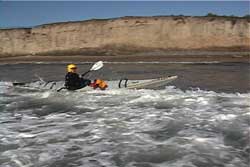 As you move closer toward shore the force of the wave lessens. As the force goes down, the less you need to edge your kayak. When you get good at side surfing, you can reduce your dependency on your brace.
As you move closer toward shore the force of the wave lessens. As the force goes down, the less you need to edge your kayak. When you get good at side surfing, you can reduce your dependency on your brace.
I like to play a little game when I get hit by a wave when broached. After the hit, I get back over my kayak and try to lift my paddle off of the whitewater, while maintaining my edge. I always try to err to the side of the wave. This way, if I lose my balance I can still brace on the wave. I try to find that sweet spot, where the amount I edge my kayak is perfect for the force pushing it and my bracing blade is just a couple of inches above the whitewater. If I loose that sweet spot, my blade is in position to provide me with support until I find that sweet spot again. When you get in shallow water you will be almost upright. How and what you do next is dependent upon your landing strategy. See USK article, "Ride A Wave And Side Surf Combo".
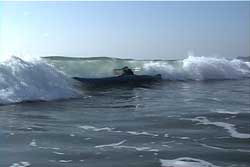 In a surf zone, the greatest release of energy from a breaking wave is when it breaks right on top of you. In the first set of pictures we had the paddler far away from the breaking spot so they could learn the basic technique for taking the side hit, after the wave has lost some energy. When a wave is small your pre-hit edging position is not radical. However, as the size of the wave increases the amount of edging needs to increase. When the force is great enough, you will need to edge your kayak and also lean your body into the wave in order to keep from capsizing. There were times I had to dive sideways (helmet first) into the wave while edging to keep from capsizing.
In a surf zone, the greatest release of energy from a breaking wave is when it breaks right on top of you. In the first set of pictures we had the paddler far away from the breaking spot so they could learn the basic technique for taking the side hit, after the wave has lost some energy. When a wave is small your pre-hit edging position is not radical. However, as the size of the wave increases the amount of edging needs to increase. When the force is great enough, you will need to edge your kayak and also lean your body into the wave in order to keep from capsizing. There were times I had to dive sideways (helmet first) into the wave while edging to keep from capsizing.
In this picture you can see the wave breaking right on the kayak. This paddler is edging and leaning into the wave because of the greater force. As I said before, how much to edge and lean will be decided by the forces you will be facing. This is kinesthetic (sensory) learning at its finest.
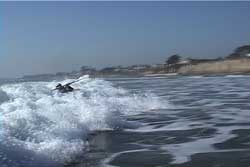 As you can see, the paddler comes up out of the breaking wave in a bracing position and in the Whitewater. The wave that hit the paddler totally engulfed him. However, by edging his kayak and adding the extra lean, he was not rolled over toward shore. The buoyancy of his kayak brought him to the surface as he was being side surfed toward shore. Did I forget to mention to hold your breath when you get hit by the wave? I think you would have figured that out on your own.
As you can see, the paddler comes up out of the breaking wave in a bracing position and in the Whitewater. The wave that hit the paddler totally engulfed him. However, by edging his kayak and adding the extra lean, he was not rolled over toward shore. The buoyancy of his kayak brought him to the surface as he was being side surfed toward shore. Did I forget to mention to hold your breath when you get hit by the wave? I think you would have figured that out on your own.
An important point to realize is the position of his high brace. In this picture his brace is just under the surface in the whitewater. In the previous picture, his brace is in the typical high brace position while maintaining good shoulder safety. Even though the wave is above the paddler's head, he is putting his brace into the wave. He is NOT trying to reach up above the wave to brace. If he did try to reach up, he would leave his shoulder open to injury. Again, read the shoulder safety article to help avoid injury.
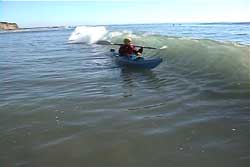 Here is another element of the side hit. The paddler is so close to the breaking wave her kayak will be lifted by the wave before the wave breaks. The wave energy lifts the water. In this case, the kayak is floating on the water that is being lifted. As the wave curls up and begins to crash down, the kayak and paddler go along for the ride.
Here is another element of the side hit. The paddler is so close to the breaking wave her kayak will be lifted by the wave before the wave breaks. The wave energy lifts the water. In this case, the kayak is floating on the water that is being lifted. As the wave curls up and begins to crash down, the kayak and paddler go along for the ride.
As you can see, the paddler is in the high brace position and she is starting to lift the knee away from the wave. When you get into a position like this you are not really going to know if the wave will lift you or break right on you. Regardless you will assume the same position. If these waves were bigger leaning into the wave would be highly recommended.
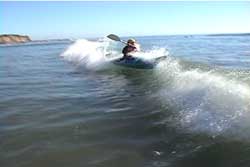 The interesting thing about being lifted by the wave are the number of different outcomes that can occur depending on where you are on the wave. This is a small wave. The drop factor is small. Imagine being dropped six to eight feet from a big wave. The impact is incredible. The sense of free fall is exciting and terrifying. Terrifying, because you know you will hit the water below and be pounded by the water above. Sometimes I remained upright. Other times I got rolled relentlessly in the wave action.
The interesting thing about being lifted by the wave are the number of different outcomes that can occur depending on where you are on the wave. This is a small wave. The drop factor is small. Imagine being dropped six to eight feet from a big wave. The impact is incredible. The sense of free fall is exciting and terrifying. Terrifying, because you know you will hit the water below and be pounded by the water above. Sometimes I remained upright. Other times I got rolled relentlessly in the wave action.
As you can see, the paddler is maintaining good boat and paddle position as she goes over the falls. If you want to learn to get good in the surf, I recommend taking some breaking waves like this when they are small. Be sure to choose a sandy beach that is deep enough, where your head doesn't hit bottom in the area where the waves are breaking.
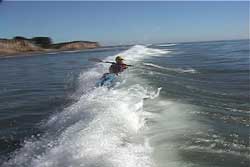 After the wave breaks we see that the paddler has remained upright. She has also got her body weight back over her kayak. She is in a solid high brace position, thus keeping her shoulders protected.
After the wave breaks we see that the paddler has remained upright. She has also got her body weight back over her kayak. She is in a solid high brace position, thus keeping her shoulders protected.
All that she needs to do now is enjoy her ride toward shore. If she keeps her kayak edged, for the forces on her boat, she will stay upright. She can brace as much as she needs if and when she loses her balance point.
I didn't mention it before in these words, but side surfing is a game of maintaining your balance in the midst of turbulence. You are trying to keep your boat on edge, while balancing your body over the cockpit. All this is being done while floating on a wave, that can be bucking like a bronco.
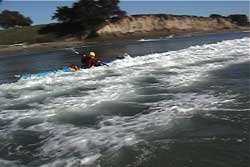 As we have seen before, when the wave gets smaller the paddler lessens the edge on their kayak. The brace is used as needed. If this paddler didn't get her weight over her kayak, this is about the time when her body would begin sinking into the whitewater wave, because there would not be enough support from the water on her brace to keep her up. Also, if you just hang on your paddle while side surfing, you end up using a lot of arm strength keeping your head above the water. It can be very fatiguing on a long ride.
As we have seen before, when the wave gets smaller the paddler lessens the edge on their kayak. The brace is used as needed. If this paddler didn't get her weight over her kayak, this is about the time when her body would begin sinking into the whitewater wave, because there would not be enough support from the water on her brace to keep her up. Also, if you just hang on your paddle while side surfing, you end up using a lot of arm strength keeping your head above the water. It can be very fatiguing on a long ride.
In all of these examples, your brace is your secondary means of support. Your kayak is your first. The only time the brace is your primary support is when your kayak is knocked out from underneath you. Then your brace is there to help you get your balance point back over your kayak.
I have often heard instructors tell students, "in order to stay up right when hit by a wave from the side, you must brace into the wave". The basic concept of this statement can be true ,but I find this statement not only misleading, I find it over simplifying a intricate movement. It is a very poor set of instructions when you say, "just brace into the wave". As we have seen, edging your kayak is what keeps you from being rolled over by the side hit. The bracing into the wave keeps you from falling over towards the wave, AFTER your kayak was knocked out from underneath you.
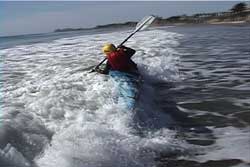 Here is an example of a student bracing into the wave. However, look at her kayak. She is edging her kayak the wrong way. If the "brace into the wave" statement were true, she would remain upright.
Here is an example of a student bracing into the wave. However, look at her kayak. She is edging her kayak the wrong way. If the "brace into the wave" statement were true, she would remain upright.
When you edge the wrong way (lifting the knee that is closest to the wave) you present the bottom of your kayak toward the force of the wave. I can tell you that the wave will roll your kayak over faster than you can imagine if you do this.
Remember the reason for the brace. You use it AFTER you get your kayak knock from under you. The brace is secondary.
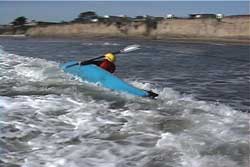 The first rule of taking the side hit is correct boat position, which is edging correctly. If you do not edge correctly, you will go over every time. Taking the side hit is a two step process that happen so fast it seems like one movement. In a slow motion review, it is correctly edge, kayak gets knocked out, brace is there to keep you from capsizing into the soup, kayak needs to be kept on edge, brace is there to allow you to get your body weight back over your kayak, combination of edging and bracing will keep you up as you side surf to shore.
The first rule of taking the side hit is correct boat position, which is edging correctly. If you do not edge correctly, you will go over every time. Taking the side hit is a two step process that happen so fast it seems like one movement. In a slow motion review, it is correctly edge, kayak gets knocked out, brace is there to keep you from capsizing into the soup, kayak needs to be kept on edge, brace is there to allow you to get your body weight back over your kayak, combination of edging and bracing will keep you up as you side surf to shore.
In this picture we see how the wave is rolling the kayak over, because the paddler edged the wrong way. In addition, once you roll toward shore, the blade toward the wave, which was once your brace, is worthless.
If you are thinking to brace up with the blade pointing toward shore, don't even try it. As soon as that shore side blade hits the water it will dive down, because your kayak is moving in the direction of the blade. Once you begin to rollover, I recommend to get into a forward tuck position and set up for a roll, after you are fully capsized and the wave has passed you by. That is if you can roll.
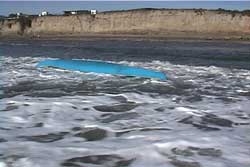 So, if you wish to avoid this paddler's fate, edge first and be ready with the brace. If you like being under the water and watching the fish swim by, then by all means, just brace into the wave and don't worry about edging your kayak.
So, if you wish to avoid this paddler's fate, edge first and be ready with the brace. If you like being under the water and watching the fish swim by, then by all means, just brace into the wave and don't worry about edging your kayak.
The reason the "brace into the wave" works sometimes, is the fact that bracing into a wave is usually accompanied by leaning into the wave. If the lucky paddler leans enough, thus edging their kayak enough, they will remain upright. However, to really master the surf zone you need reliable techniques. When you use proper boat, body and blade movements, you will have other options at your disposal. To see some of those options, read USK article, "Side Surfing Control".
As you have read, there is a lot to consider when taking a side hit from a wave. If you want to get a feel of the side hit in calm water, read USK article, "Calm Water Surf/Preparing For The Surf Zone".
Even though I believe successfully managing a side hit is the most important skill to have when entering the surf zone, it is only one aspect of surviving the surf zone. Timing, strategies, quality strokes and control are also necessary to have when you choose to paddle your kayak in a surf zone. See the following USK articles for more information.
"How To Punch Through Surf"
"In-Out Surf Landing"
"Back In Surf Landing"
I will close with my opening remarks. The surf zone can be a fun place to play, if you are properly trained and prepared. Surf is a reality of any large body of water. Rather than learning just how to get through it, spend some time and resources to learn how to enjoy your surf zone experience. Learning how to take that side hit from a wave will make all the difference.
Pictures seen above were taken from the Award Winning USK Video "ABC'S
of the Surf Zone"
USK Home
Page
© Copyright USK
 Here is what many see as their worst case scenario. Your kayak is parallel to an oncoming whitewater wave. This wave has just broken and the wave energy going through the water will push this whitewater forward towards shore. This is unlike the swell zone where the wave energy just lifts your kayak as the swell passes under. This whitewater wave is a moving force that is coming at you and your kayak.
Here is what many see as their worst case scenario. Your kayak is parallel to an oncoming whitewater wave. This wave has just broken and the wave energy going through the water will push this whitewater forward towards shore. This is unlike the swell zone where the wave energy just lifts your kayak as the swell passes under. This whitewater wave is a moving force that is coming at you and your kayak. In this second illustration, the paddler is waiting to take the side hit with their kayak on edge. You will also notice they are NOT leaning over the side to edge their boat. They are still centered over their kayak with their kayak on edge by lifting the knee opposite the wave. In addition, this paddler is waiting in a high brace position which will be discussed after reviewing boat and body movements.
In this second illustration, the paddler is waiting to take the side hit with their kayak on edge. You will also notice they are NOT leaning over the side to edge their boat. They are still centered over their kayak with their kayak on edge by lifting the knee opposite the wave. In addition, this paddler is waiting in a high brace position which will be discussed after reviewing boat and body movements.  You can see that the paddler is over on their side, because the wave knocked the kayak out from under their center of gravity. Their body has ended up in the soup (Whitewater). The reason they do not go completely over is because they are using their paddle as a brace. In the previous picture you see the paddler ready in the high brace position while they edged their kayak. Now you see why. The bracing blade, which is in the water, is being lifted by the very force that is pushing the whitewater toward shore. In fact, the larger the wave the more lift that is provided.
You can see that the paddler is over on their side, because the wave knocked the kayak out from under their center of gravity. Their body has ended up in the soup (Whitewater). The reason they do not go completely over is because they are using their paddle as a brace. In the previous picture you see the paddler ready in the high brace position while they edged their kayak. Now you see why. The bracing blade, which is in the water, is being lifted by the very force that is pushing the whitewater toward shore. In fact, the larger the wave the more lift that is provided. As you can see, the paddler has moved their body position from over the paddle, to back over their kayak. While doing so, they have also kept their kayak on edge. If they sat completely upright, with their kayak flat to the water, they would be rolled over toward shore. Your goal should be, to take the hit and regain your balance point over your kayak as soon as you can. Your brace allows you to move your body back over your kayak. Once balanced over your kayak, you still need to maintain your brace on the wave. By keeping your weight over your edged kayak, you will need very little lift from the wave, on your brace, to keep you upright. As you advance, you will see that being balanced over your kayak, while side surfing toward shore, will provide you with numerous options, as compared to resting your body weight on your brace until you sink.
As you can see, the paddler has moved their body position from over the paddle, to back over their kayak. While doing so, they have also kept their kayak on edge. If they sat completely upright, with their kayak flat to the water, they would be rolled over toward shore. Your goal should be, to take the hit and regain your balance point over your kayak as soon as you can. Your brace allows you to move your body back over your kayak. Once balanced over your kayak, you still need to maintain your brace on the wave. By keeping your weight over your edged kayak, you will need very little lift from the wave, on your brace, to keep you upright. As you advance, you will see that being balanced over your kayak, while side surfing toward shore, will provide you with numerous options, as compared to resting your body weight on your brace until you sink.  As you move closer toward shore the force of the wave lessens. As the force goes down, the less you need to edge your kayak. When you get good at side surfing, you can reduce your dependency on your brace.
As you move closer toward shore the force of the wave lessens. As the force goes down, the less you need to edge your kayak. When you get good at side surfing, you can reduce your dependency on your brace.  In a surf zone, the greatest release of energy from a breaking wave is when it breaks right on top of you. In the first set of pictures we had the paddler far away from the breaking spot so they could learn the basic technique for taking the side hit, after the wave has lost some energy. When a wave is small your pre-hit edging position is not radical. However, as the size of the wave increases the amount of edging needs to increase. When the force is great enough, you will need to edge your kayak and also lean your body into the wave in order to keep from capsizing. There were times I had to dive sideways (helmet first) into the wave while edging to keep from capsizing.
In a surf zone, the greatest release of energy from a breaking wave is when it breaks right on top of you. In the first set of pictures we had the paddler far away from the breaking spot so they could learn the basic technique for taking the side hit, after the wave has lost some energy. When a wave is small your pre-hit edging position is not radical. However, as the size of the wave increases the amount of edging needs to increase. When the force is great enough, you will need to edge your kayak and also lean your body into the wave in order to keep from capsizing. There were times I had to dive sideways (helmet first) into the wave while edging to keep from capsizing. As you can see, the paddler comes up out of the breaking wave in a bracing position and in the Whitewater. The wave that hit the paddler totally engulfed him. However, by edging his kayak and adding the extra lean, he was not rolled over toward shore. The buoyancy of his kayak brought him to the surface as he was being side surfed toward shore. Did I forget to mention to hold your breath when you get hit by the wave? I think you would have figured that out on your own.
As you can see, the paddler comes up out of the breaking wave in a bracing position and in the Whitewater. The wave that hit the paddler totally engulfed him. However, by edging his kayak and adding the extra lean, he was not rolled over toward shore. The buoyancy of his kayak brought him to the surface as he was being side surfed toward shore. Did I forget to mention to hold your breath when you get hit by the wave? I think you would have figured that out on your own. Here is another element of the side hit. The paddler is so close to the breaking wave her kayak will be lifted by the wave before the wave breaks. The wave energy lifts the water. In this case, the kayak is floating on the water that is being lifted. As the wave curls up and begins to crash down, the kayak and paddler go along for the ride.
Here is another element of the side hit. The paddler is so close to the breaking wave her kayak will be lifted by the wave before the wave breaks. The wave energy lifts the water. In this case, the kayak is floating on the water that is being lifted. As the wave curls up and begins to crash down, the kayak and paddler go along for the ride. The interesting thing about being lifted by the wave are the number of different outcomes that can occur depending on where you are on the wave. This is a small wave. The drop factor is small. Imagine being dropped six to eight feet from a big wave. The impact is incredible. The sense of free fall is exciting and terrifying. Terrifying, because you know you will hit the water below and be pounded by the water above. Sometimes I remained upright. Other times I got rolled relentlessly in the wave action.
The interesting thing about being lifted by the wave are the number of different outcomes that can occur depending on where you are on the wave. This is a small wave. The drop factor is small. Imagine being dropped six to eight feet from a big wave. The impact is incredible. The sense of free fall is exciting and terrifying. Terrifying, because you know you will hit the water below and be pounded by the water above. Sometimes I remained upright. Other times I got rolled relentlessly in the wave action. After the wave breaks we see that the paddler has remained upright. She has also got her body weight back over her kayak. She is in a solid high brace position, thus keeping her shoulders protected.
After the wave breaks we see that the paddler has remained upright. She has also got her body weight back over her kayak. She is in a solid high brace position, thus keeping her shoulders protected.  As we have seen before, when the wave gets smaller the paddler lessens the edge on their kayak. The brace is used as needed. If this paddler didn't get her weight over her kayak, this is about the time when her body would begin sinking into the whitewater wave, because there would not be enough support from the water on her brace to keep her up. Also, if you just hang on your paddle while side surfing, you end up using a lot of arm strength keeping your head above the water. It can be very fatiguing on a long ride.
As we have seen before, when the wave gets smaller the paddler lessens the edge on their kayak. The brace is used as needed. If this paddler didn't get her weight over her kayak, this is about the time when her body would begin sinking into the whitewater wave, because there would not be enough support from the water on her brace to keep her up. Also, if you just hang on your paddle while side surfing, you end up using a lot of arm strength keeping your head above the water. It can be very fatiguing on a long ride. Here is an example of a student bracing into the wave. However, look at her kayak. She is edging her kayak the wrong way. If the "brace into the wave" statement were true, she would remain upright.
Here is an example of a student bracing into the wave. However, look at her kayak. She is edging her kayak the wrong way. If the "brace into the wave" statement were true, she would remain upright. The first rule of taking the side hit is correct boat position, which is edging correctly. If you do not edge correctly, you will go over every time. Taking the side hit is a two step process that happen so fast it seems like one movement. In a slow motion review, it is correctly edge, kayak gets knocked out, brace is there to keep you from capsizing into the soup, kayak needs to be kept on edge, brace is there to allow you to get your body weight back over your kayak, combination of edging and bracing will keep you up as you side surf to shore.
The first rule of taking the side hit is correct boat position, which is edging correctly. If you do not edge correctly, you will go over every time. Taking the side hit is a two step process that happen so fast it seems like one movement. In a slow motion review, it is correctly edge, kayak gets knocked out, brace is there to keep you from capsizing into the soup, kayak needs to be kept on edge, brace is there to allow you to get your body weight back over your kayak, combination of edging and bracing will keep you up as you side surf to shore.  So, if you wish to avoid this paddler's fate, edge first and be ready with the brace. If you like being under the water and watching the fish swim by, then by all means, just brace into the wave and don't worry about edging your kayak.
So, if you wish to avoid this paddler's fate, edge first and be ready with the brace. If you like being under the water and watching the fish swim by, then by all means, just brace into the wave and don't worry about edging your kayak.